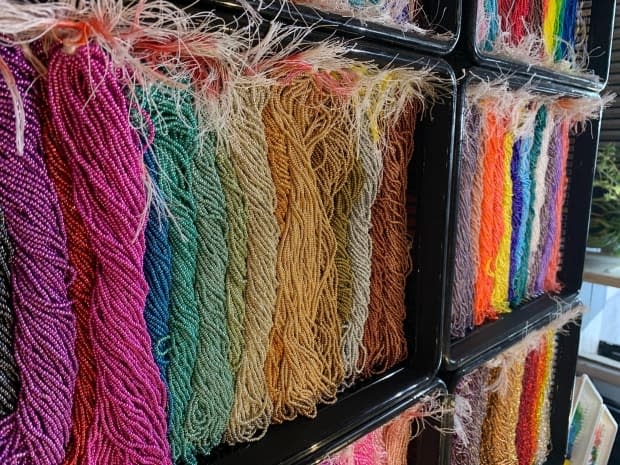Known as 'Beadman,' Oskenontona Philip Deering sees a bright future for an ancient tradition
Oskenontona Philip Deering sees working with beads as a way for people to connect with each other, predating modern language — even going back millennia.
Deering, whose shop in Kahnawake provides that essential part of Indigenous beadwork to the community, is known to many simply as Beadman.
"We don't get as many customers as we need to stay afloat so I go out on the road," he told CBC Montreal's Let's Go.
Before the pandemic, he would regularly visit Indigenous communities in Quebec and Ontario, as well as travel to the Atlantic provinces and Manitoba to sell his beads.
It's when he was invited to visit Cree communities along James Bay that he was given the nickname.
"The first community I went to, they said, 'Hey, Beadman's here!" says Deering, who has been selling beads full time for two decades.
"They started calling me Beadman, nobody knew my name."
The moniker stuck, enough that when Kahnawake locked down, he opened a shop in Montreal called The Beadman Emporium

The emporium is now part of the Métèque art space in Notre-Dame-de-Grâce, where the exhibit Bead By Bead is currently on display.
The exhibit is a collaboration with Native-Immigrant Art Hive, where Deering is a cultural interpreter.
"We can sell on the internet, and with COVID we actually have to … but you want to see the colours right there and touch the beads, look at the quality of the beads," Deering said.
He says beadwork is "a community tradition" in his family going back generations.
His great-great grandmother sold beadwork at the Canadian National Exhibition in Toronto in the late 1800s, and his mother did the same nearly a century later.
During the industrial revolution, "all kinds of jobs or ways of living that people had went by the wayside. People had to find new skills, new trades to work at," Deering said.

"During that time, beadwork was kind of a fallback position"
It was seeing his mother do her beadwork, and travelling with her, that taught him its significance.
She would stop at other Indigenous communities along the way to purchase more beadwork to increase her stock by the time they reached Toronto.
It was from his mother that he learned: if you want to sell beads, the best way is to visit people.
Young artists breathe new life into tradition
While he said interest in the craft seemed to diminish near the end of the 20th century, a new generation of artists has reinvigorated the practice.
"There are new kinds of beads that we never saw before … Once the powwows reopen you can visit and see that beadwork is a booming trade right now."
He points to beads that are tens of thousands of years old found in Africa and the Middle East to show that it's a tradition long observed around the world.
Those beads go beyond ceremonial purposes, he says — they were used to record events before humans had the words to describe them.
"Human language is a symbolic process, it requires the ability to think symbolically. And beads also can be a symbol," he said.
"As Iroquois people we would use beads to record our treaties and agreements and also to use them for various social gatherings and invitations. The list goes on and on."
He says beadwork illustrates "our ability to work together in harmony."
The Bead by Bead exhibition continues until Dec. 6 at Métèque (5442 Côte-Saint-Luc Rd.), more information here.
Listen to the full segment on Let's Go below:


